|

by J. Deardorff1,
B. Haisch2,
B. Maccabbe3
and H.E. Puthoff4
Journal of the British Interplanetary
Society
(JBIS)
Vol. 58, pp. 43-50, 2005
from
UFOWhipNet Website
|
1.
1689 S.W. Knollbrook Pl., Corvallis, Oregon 97333, USA.
2. National Aviation Reporting Center on
Anomalous Phenomena (NARCAP), Post Office Box 1535,
Vallejo, California, USA.
3. Fund for UFO Research, Post Office Box 277, Mt
Rainier, Maryland, 20712, USA.
4. Institute for Advanced Studies at Austin, 4030
W. Braker Ln., Suite 300, Austin, Texas 78759, USA.
It has
recently been argued that anthropic reasoning applied to
inflation theory reinforces the prediction that we
should find ourselves part of a large, galaxy-sized
civilization, thus strengthening Fermi’s paradox
concerning “Where are they?” Furthermore, superstring
and M-brane theory allow for the possibility of parallel
universes, some of which in principle could be
habitable.
In
addition, discussion of such exotic transport concepts
as “traversable wormholes” now appears in the rigorous
physics literature. As a result, the “We are alone”
solution to Fermi’s paradox, based on the constraints of
earlier 20th century viewpoints, appears today to be
inconsistent with new developments in our best current
physics and astrophysics theories. Therefore we
reexamine and reevaluate the present assumption that
extraterrestrials or their probes are not in the
vicinity of Earth, and argue instead that some evidence
of their presence might be found in certain high-quality
UFO reports.
This study
follows up on previous arguments that (1) interstellar
travel for advanced civilizations is not a priori ruled
out by physical principles and therefore may be
practicable, and (2) such advanced civilizations may
value the search for knowledge from uncontaminated
species more than direct, interspecies communication,
thereby accounting for apparent covertness regarding
their presence. |
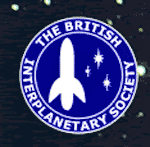
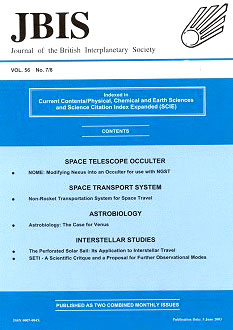
1.
Introduction
The ever recurring question of why Earth has seemingly not been
visited by extraterrestrials (ETs) has received considerable
discussion under the topic of ‘Fermi’s paradox’. The problem
originated as a quip by Enrico Fermi to colleagues in Los
 Alamos
over lunch one day in 1950. Whether one assumes the existence of
only one other civilization or of many alien civilizations in our
Milky Way galaxy, and whether one assumes colonization involving
interstellar travel at near-light speed or far below, diffusion
modeling predicts colonization or at least visitation of all
habitable planets in the galaxy on timescales of tens of millions of
years, far less than the approximate 13 x 109 year age of the galaxy
itself. Alamos
over lunch one day in 1950. Whether one assumes the existence of
only one other civilization or of many alien civilizations in our
Milky Way galaxy, and whether one assumes colonization involving
interstellar travel at near-light speed or far below, diffusion
modeling predicts colonization or at least visitation of all
habitable planets in the galaxy on timescales of tens of millions of
years, far less than the approximate 13 x 109 year age of the galaxy
itself.
Thus the paradox: Where are they
[1]? Theoretical possibilities unknown to
Fermi make the paradox even
stronger today. One can now rationally conjecture about prospects
afforded by adjacent M-brane universes
[2]. Indeed, if the multidimensions underlying
superstring and
M-brane theory are
correct, there could be inhabited universes separated from our own
by minute, orthogonal distances. Also, anthropic reasoning has
recently been applied to inflation theory, arriving once again at
the conclusion that we should find ourselves within an enormously
larger galactic civilization [3].
While the ‘We are alone’ solution to
Fermi’s paradox was once a seemingly valid one, this answer is now
incompatible with the infinite universe and random self-sampling
assumption consistent with inflation theory. We thus find ourselves
in the curious position that current cosmological theory predicts
that we should be experiencing extraterrestrial visitation.
At the
same time, current physics and astrophysics suggest that such
visitation may not be as impossible as had been thought.
2. Recent Scientific
Advances
In recent astronomical discoveries, over 100 exoplanets have been
catalogued, with detection sensitivity now increased to the point
where, in one instance, a Jupiter-sized planet was deduced to be in
a Jupiter-like orbit around a Sol-like star
[4]. In the field of
exobiology, much recent activity suggests that some of the building
blocks for life may originate in space as well as be transported by
meteorites [5-6]. The possibility of widespread
panspermia has
received new impetus [7-8]. These
 findings
and studies make plausible the hypothesis that there is intelligent
life elsewhere in the universe. This is, of course, the fundamental
assumption made by the proponents of SETI, the Search for
Extraterrestrial Intelligence using microwave or optical means of
detection. findings
and studies make plausible the hypothesis that there is intelligent
life elsewhere in the universe. This is, of course, the fundamental
assumption made by the proponents of SETI, the Search for
Extraterrestrial Intelligence using microwave or optical means of
detection.
The extraterrestrial hypothesis (ETH), that intelligent life from
‘elsewhere’ in the universe could be visiting Earth, has become less
implausible through suggestions that the velocity-of-light
constraint ‘they can’t get here from there’ is not as
restricting as had been assumed previously. This restriction has its
origin in the special theory of relativity, which we do not
question. However, within the context of general relativity (GR)
there are three approaches which may permit legitimately bypassing
this limit, given sufficiently advanced (perhaps by millions of
years!) knowledge of physics and technology.
One approach popularized by Thorne and
Sagan concerns the possibility of wormholes, or cosmic subways, a
form of shortcut through the space-time metric
[9]. Using the
standard GR as a basis, certain mathematical requirements for
traversable wormholes have been derived and published in the
scientific literature and it appears that there is the possibility
of engineering a wormhole metric, at least in principle
[10]. A
second more recent approach published in the GR literature has been
dubbed the ‘Alcubierre Warp Drive’ [11-12].
Unlike the speed of light limit through
space, there is no limit to the speed at which space itself might
stretch. Faster than light (FTL) relative motion is part of
inflation theory, and presumably the universe beyond the Hubble
distance is receding from us faster than c. It was shown that a
spaceship contained in a volume of Minkowski space could in
principle make use of FTL expansion of space-time behind and a
similar contraction in front, with the inconvenience of time
dilation and untoward accelerations being overcome. A related
approach involves constructing a ‘Krasnikov tube’
[13] to connect
spatially remote locales. Of course so-called exotic matter would be
required for either case.
If GR itself were to be reinterpreted in terms of a polarisable
vacuum as first proposed by Dicke
[14], this would open the
possibility of a different type of metric engineering in which the
dielectric properties of the vacuum might be altered in such a way
as to raise the local propagation velocity of light. In effect one
would be creating a local index of refraction of less than unity
[15].
Finally, there is the conjectured possibility of making use of the
additional dimensionalities of M-brane and superstring theory to
transfer into adjacent universes where the speed of light limit may
be quite different and reentering our universe at the desired
location. This is by far the most speculative possibility.
Clearly when it comes to engineering warp drive or wormhole
solutions, seemingly insurmountable obstacles emerge, such as
unattainable energy requirements [16] or the need for exotic matter
[17]. Thus, if success is to be achieved, it must rest on some yet
unforeseen breakthrough about which we can only speculate, such as a
technology to cohere otherwise random vacuum fluctuations
[18].
Nonetheless, the possibility of reduced-time interstellar travel by
advanced extraterrestrial (ET) civilizations is not, as naive
consideration might hold, fundamentally ruled out by presently known
physical principles. ET knowledge of the physical universe may
comprise new principles which allow some form of FTL travel. This
possibility is to be taken seriously, since the average age of
suitable stars within the ‘galactic habitable zone’, in which the
Earth also resides, is found to be about 109 years older than the
sun [19] suggesting the possibility of civilizations extremely
advanced beyond our own.
There are further reasons why the ‘We are alone’ solution to Fermi’s
paradox should perhaps be set aside in favor of the ETH. A
previously preferred solution, that biogenesis is an exceedingly
rare event in conjunction with both panspermia and interstellar
travel being inoperative [1], is now scarcely tenable in light of
the cosmological considerations already discussed. The ETH appears
to be the most viable remaining solution, where ‘ET’ is taken in a
general non-Earthly sense that could include extra-dimensional
realms, as in M-brane and superstring theory.
Given the highly advanced ET science and
technology to be expected in considerably older civilizations,
coupled with the many observational reports since WWII of highly
advanced technology seemingly operating at will within Earth’s
skies, it is only logical to search for evidence of ET visitations
in at least a fraction of the ongoing, unexplainable reports
popularly referred to as ‘UFO sightings.’ Reluctance to do so could
result in our failure to realize that observations of ‘genuine’ ET
visitations have been occurring. This approach, which we follow
here, explores the likelihood that ‘we actually do belong to a large
civilization but are unaware of that fact’
[3]
3. U.S. Air Force
Response (1947-1969)
Reports of unknown objects in the skies, appearing as some sort of
flying craft and exhibiting extraordinary manoeuvres, first became
known to the general public in 1947. The first publicized sighting
occurred on June 24 of that year, after which there were many
hundreds of sightings during the following months. The phenomenon
has been continuing ever since [20-24].
At first the U.S. Air Force collected the sighting reports for
analysis in its operation
Project Sign (1948-1949). This was
succeeded by
Project Grudge (1949-1952) and then
Project Blue Book
(1952-1969) [20, 25] . Some 20% of
Project Blue
 Book’s
sightings from 1953-1965 were left unexplained, if their
‘insufficient data’ category is included
[22]. The Battelle Memorial
Institute (BMI; Columbus, Ohio) discovered, in their study of 3,201
reports from 1947 through 1952, that the percentage of unknowns
(unexplainable sightings) increased with increasing quality of the
sighting information and reliability of the observers
[21]. A
surprisingly high percentage, 30%, of the civilian sightings, and an
even more surprising 38%, of the military sightings rated as
excellent in quality were listed as unknown. Book’s
sightings from 1953-1965 were left unexplained, if their
‘insufficient data’ category is included
[22]. The Battelle Memorial
Institute (BMI; Columbus, Ohio) discovered, in their study of 3,201
reports from 1947 through 1952, that the percentage of unknowns
(unexplainable sightings) increased with increasing quality of the
sighting information and reliability of the observers
[21]. A
surprisingly high percentage, 30%, of the civilian sightings, and an
even more surprising 38%, of the military sightings rated as
excellent in quality were listed as unknown.
On the other hand, only about 15% of the
civilian and 20% of the military sightings rated as poor were
unknown. The increase in the percentage of unknowns with increasing
quality of the report is an unexpected result if sightings were all
explainable as mistakes (failure to correctly identify the sighted
phenomenon) by either the observer(s) or the scientists who analyzed
the sightings. In this collection of 3,201 sightings none were
listed as hoaxes and only 1.5% were listed as caused by
psychological effects. This result discovered during the several
year long BMI study refutes the claim, made in
the Condon Report
[22], that UFO reports are from ‘less well informed individuals,’
who are ‘not necessarily reliable.’
It is worthy of note that Condon had
access to the results of the BMI study but there is no reference to
it in the Condon Report.
Project Blue Book culminated in 1969 with
the government sponsored Condon Report
[22]. In the opening section
of the Report its director concluded that, after years of
investigation, the U.S. Air Force had found nothing truly
newnothing that supported claims of new physics or the ETH and
that continued investigation probably would not find anything truly
new in the future. The Report recommended that the Air Force end its
investigation project, which it did in late 1969.
4. The Condon
Report (1968)
In the late 1960’s, the U.S. Air Force issued a contract to the
University of Colorado to carry out a scientific study of evidence
concerning the UFO phenomenon. The director of the project was Prof.
Edward U. Condon, a distinguished and influential physicist who made
no secret of his opinion even at the outset that no substantive
evidence for extraterrestrial visitation was liable to result. The
study was relatively brief (2 years) and had a notably low budget
(app. $500K) for a serious scientific study.
When
the Condon Report was released in
1968, the American scientific community accepted its apparently
negative conclusion concerning evidence for extraterrestrial
visitation in a generally uncritical way, and to some extent even an
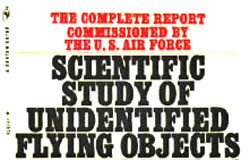 enthusiastic
way since it offered an end to a troublesome situation. An
endorsement of the Report by the National Academy of Sciences took
place following an unusually rapid review and the Air Force quickly
used the Report as a justification to terminate any further public
involvement with the topic. enthusiastic
way since it offered an end to a troublesome situation. An
endorsement of the Report by the National Academy of Sciences took
place following an unusually rapid review and the Air Force quickly
used the Report as a justification to terminate any further public
involvement with the topic.
The negative conclusion of the Report is more apparent than real
however, since there is a substantial discrepancy between the
conclusion in the “Summary of the Study” written by Condon
single-handedly, and the conclusion one could reasonably draw from
the evidence presented in the main body of the Report. Such a
dichotomy was possible because the study was a project for which the
director, Condon, had sole authority; it was not the work of a
committee whose members would have to reach some consensus
conclusion. An analysis of the Condon Report by Sturrock
[26]
details the many disagreements between Condon’s dismissive summary
and the actual data.
Given the thousand-page length of the Report, one can safely assume
that very few in the scientific community would have devoted the
time necessary to read the entire document. The impact of the Report
was thus largely due to Condon’s leveraging his prestigious
scientific reputation into an acceptance of his own personal views
as representing the apparent outcome of a scientific investigation.
Indeed, as Sturrock documents, Condon actually took no part in the
investigations and indicated the conclusion he intended to draw well
before the data were properly examined, hardly a scientific
approach.
The portion of the Condon Report that
contains its sighting analyses does not support the “Summary of the
Study” written by Condon [26]. Many of the events presented within
its Case Studies section do fall into the ‘unidentified’ category of
UFOs, for which the Report’s definition was, in essence:
‘A puzzling
stimulus for a report of something seen in the sky or landed on the
earth that could not be identified as having an ordinary natural
origin.’
In a detailed review of this Report, however, it was noted
that ‘The sheer bulk of the report, much of it “scientific padding”,
cannot conceal from anyone who studies it closely that it examines
only a tiny fraction of the really puzzling UFO reports, and that
its scientific argumentation is often unsatisfactory. Of roughly
ninety cases that it specifically confronts, more than thirty are
conceded to be unexplained’ [27].
Four of the cases, reanalyzed and
reported in detail at the 1969 AAAS Symposium, disclosed how
unscientific the Condon Report’s treatment of them had been; the
reanalyzes have since gone unrefuted. Hence we cannot agree with the
Condon Report’s assertion that the phenomenon provides no new
subjects for science to explore, given that many sightings were left
unexplained. Furthermore, in many of the cases that the Report
claimed to have identified, that goal was achieved merely through
assuming that the witnesses had seen something differing in detail
from what they had reported. Also, a committee of the American
Institute of Aeronautics and Astronautics in 1971 found,
‘it
difficult to ignore the small residue of well-documented but
unexplainable cases that form the hard core of the UFO
controversy’[28].
Clearly, the Condon Report was left in an
unsatisfactory state [20,24-26,29-30].
The primary conclusion of the Condon panel sidestepped the main
issue, the failure to explain every sighting, by saying:
‘The
evidence presented on Unidentified Flying Objects shows no
indication that these phenomena constitute a direct physical
threat to national security’ [22].
This is not inconsistent,
however, with some fraction of unexplained reports representing
actual ET visitations.
5.
Re-Evaluation of the Phenomenon Needed
5.1 Sightings Since the Condon Report
The self-inconsistency of
the Condon Report, along with the strengthening of Fermi’s
paradox through recent developments in cosmology, physics,
astronomy and astrobiology, are but two reasons to reevaluate
the UFO phenomenon. Another reason is that remarkable sightings
did not cease with the publication of the Condon Report in 1969.
Many detailed sightings since then have become available for
examination. Scientists should
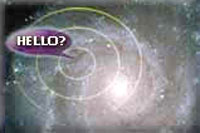 not
feel reluctant to study these inasmuch as the Report’s executive
summary stated that ‘any scientist with adequate training and
credentials who does come up with a clearly defined, specific
proposal for study [of UFO reports] should be supported.’ not
feel reluctant to study these inasmuch as the Report’s executive
summary stated that ‘any scientist with adequate training and
credentials who does come up with a clearly defined, specific
proposal for study [of UFO reports] should be supported.’
One example of sightings worth
studying are those that occurred on December 31, 1978 off the
northeast coast of South Island, New Zealand. These involved
several channels of information recorded on tape and film during
the sightings, correlated visual air- and ground-radar
detections and light phenomena recorded on colour movie film as
well as reports by the eight witnesses who were involved.
Analysis of the recorded data and of the witness testimony
indicates that unknown objects emitting bright light were
detected on radar, filmed and apparently moved in response to
the motions of the airplane carrying the witnesses. The
sightings have defied all mundane explanations [31-32].
Some investigations of unexplainable sightings have been
sponsored by governments outside the U.S.
Since 1977 the French
Space Agency has carried out an official investigation of UFO
reports with its project GEPAN, later called SEPRA. In the
Belgium sighting wave of 1989-90, civilian and military
officials cooperated in sharing eyewitness, radar and
video-image data of triangular-shaped craft.
5.2 Withheld Information Now
Available
The Condon investigators
did not have full access to the information and analysis
compiled previously by the U.S. Air Force Office of Intelligence
(AFOIN) or to all the information collected by Project Blue
Book.
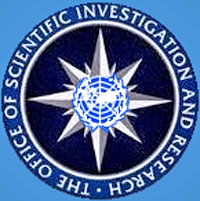 Much
of this information has been disclosed in the years since 1968.
The information release has come about on five fronts. Much
of this information has been disclosed in the years since 1968.
The information release has come about on five fronts.
First, the U.S. Air Force released the complete files of Project
Blue Book in 1975. This release included the previously
unavailable files of the Air Force Office of Special
Investigation (AFOSI).
Second, the U.S. Freedom of Information Act, which went into
effect in the mid 1970s, resulted in the release of relevant
information from other agencies (Federal Bureau of
Investigation: FBI, in 1977; Central Intelligence Agency: CIA,
in 1978; etc.), though often in a censored form
[23-24]. A third
new source of information is the collection of previously
withheld reports and analyses carried out by the AFOIN in the
late 1940s and early 1950s.
This information has been released
in the last 20 years as a result of standard declassification
requirements for old documents. It shows that Air Force
intelligence privately concluded that as many as 5% of the
sightings were unexplainable even though they were apparently
accurate reports made by credible observers, thus contradicting
the public statements of the Air Force that all sightings could
be explained. The documents provide an explanation as to why Air
Force intelligence told the FBI in August and again in October,
1952, that some top Air Force officials were seriously
considering the ‘interplanetary’ explanation
[33].
Fourth, governments of countries other than the United States,
over the last 25 years, have released relevant information
collected by their armed services and police. Not only has the
French government, through GEPAN and SEPRA, released sighting
documents but also England’s Ministry of Defense recently
released a number of documents. The governments of Spain and
Canada also released documents in the 1970s and 1980s. Moreover,
some governments besides that of France have official
investigative groups on this topic.
In 1997, in response to civilian and
military sightings over the previous years, the Chilean Air
Force formed the Committee for the Study of Anomalous Phenomena
(acronym, CEFAA in Spanish) directed by a former Air Force
general and headquartered in the Technical School of Aeronautics
in Santiago. One of us (Maccabee) was invited to Chile in 1999
to lecture at a symposium sponsored by the CEFAA and to discuss
the sightings. The Peruvian Air Force set up a similar group in
2001. Brazil and Uruguay also have comparable investigative
groups.
A fifth new source of information not available or utilized by
the Condon group consists of the many witnesses to events in the
1940-1960 decades who had worked for the government or the
military and after reaching retirement age, have come forward to
divulge their first-hand knowledge
[34]. They have felt it was
more important for the citizens to know what has been taking
place than to continue to obey instructions to maintain silence
about it. A reluctance to report UFO events arose because of a
curtain of ridicule which, since the 1950s, had settled over the
subject. It was induced in part by the CIA’s 1953
Robertson
Panel that recommended a debunking programme against the reality
of the phenomenon [20,22-23].
The debunking is most often implemented by an authority figure
asserting, at his own volition and without interviewing the
witnesses, that whatever was observed and reported as
extraordinary was instead the misidentification of something
mundane. This is demeaning to sincere, credible witnesses. The
major news media quickly picked up on sarcastic phrases like
‘little green men’ and ‘UFO buffs’, then gradually weaned
themselves away from the topic reporters, editors and
corporate owners fear ridicule, whether just or unjust, as much
as do scientists and politicians.
The refusal of the U.S. Air Force in
the 1950s and 1960s to release sighting data it had collected
only added to the problem, since evidence collected by the
government was not available to support the witnesses
[33]. The
first director of the CIA assessed the situation in 1960 as
follows: ‘Behind the scenes, highranking Air Force officers are
soberly concerned about UFOs. But, through official secrecy and
ridicule, many citizens are led to believe the unknown flying
objects are nonsense to hide the facts, the Air Force has
silenced its personnel’ [35].
The Condon Report also added to the
problem, since it demonstrated that men of science could simply
allege that witnesses are mistaken or dishonest and they would
be believed by most of their colleagues even though they had no
evidence to back up their allegations. This in turn led to
greater reluctance on the part of witnesses to come forward. As
a result, ‘the most credible UFO witnesses are often those most
reluctant to come forward with a report of the event they have
witnessed’ [27]. This ridicule factor has prevented many serious
investigators from even attempting to report their findings
within the journals preferred by most scientists.
Therefore, one of the recommendations made by the moderator of a
1997 panel of scientists is that journal editors should change
their policy of refusing to even seriously consider publishing
articles related to the UFO phenomenon, so that this difficulty
may be alleviated [36].
6. Inferring an ET
Strategy
If one allows that at least some unexplainable sightings may be
manifestations of extraterrestrial intelligence, then there is yet
another reason for reevaluation: a growing recognition over the past
two decades that a large part of the behavior manifested can be
viewed as being quite rational. The topic of ET behavior has
received considerable discussion in
 connection
with SETI in the past three decades. SETI has proceeded on the
assumption that Fermi's paradox is to be solved through continued
and enhanced searching of the sky for electromagnetic signals
indicative of ET communications [37]. Several possible reasons for
lack of success to date have been proposed
[1,37-38]. connection
with SETI in the past three decades. SETI has proceeded on the
assumption that Fermi's paradox is to be solved through continued
and enhanced searching of the sky for electromagnetic signals
indicative of ET communications [37]. Several possible reasons for
lack of success to date have been proposed
[1,37-38].
Since the 1970s advocates of a covert ET presence in our vicinity
have also been advancing their hypotheses or scenarios. They reject
as improbable the assumption that space-faring ETs must be dominated
by the most evil and aggressive of their kind an assumption whose
consequence would be that we should not be existing as a freely
developing civilization within a fully colonized and/or explored
galaxy. Contact optimists instead presume that many advanced ET
groups are at least as ethical as we are, while still attending to
their own safety and security.
The ET motivation for space travel could
be to increase their knowledge through exploration of space rather
than to colonize and seek domination [39]. Thus hypotheses have been
set forth regarding why such ETs would be aware of our presence but
not yet have contacted us overtly. Among these are the zoo, nursery
and quarantine or embargo hypotheses [1,38,40-42]. Most of these
posit that the ETs involved have frequently scouted us out
semi-covertly and have concluded that we are either not yet mature
enough for open contact, or not prepared for it, since any abrupt,
overt contact could cause societal chaos and governmental downfalls.
Also postulated is that ET interference
with our society would prematurely bring an end to our
civilisation’s continued development if it occurred before our
knowledge has progressed to the point that we could understand where
the aliens could have originated and how great their head start over
us could be [39].
A serious inconsistency in this reasoning, however, is that
maintenance of total ET covertness towards Earth and the solar
system would still lead to societal chaos whenever the covertness or
embargo was eventually lifted, unless the ETs carried out a
programme of gradual disclosure a ‘leaky’ embargo
[1,43]. Although
the zoo or embargo hypothesis may be unverifiable, the leaky-embargo
hypothesis may be verifiable if the UFO evidence is taken into
account. Much of this evidence appears to constitute just such a
leak in the embargo: a grass-roots educational programme in the form
of the phenomenon, which has been in operation since 1947, if not
before.
Many sightings have been of a nature to attract attention to
their craft and let isolated groups of witnesses know that its
occupants are aware of us [24,44]. A key category of such cases
involves reports wherein persons within a traveling vehicle
frantically witness an object pacing them even though their
automobile or aircraft makes turns that rule out the sighting of an
astronomical or other ordinary object as any explanation.
Similarly, in a number of the aircraft
cases the unknown object, which was either pacing the aircraft or
presenting itself to it, was detected on radar as well as visually
[23-25,27]. The object’s extraordinary appearance, manoeuvreability
and oft-times coincidental interference with the vehicle’s
electrical system additionally rule out mundane explanations
[23-25].
Although individual,
localized and usually brief sightings
may have provided sufficient evidence to be convincing to the
observers and sighting analysts, the fact is that, since the
widely-reported sightings began in 1947, no event has persisted in a
prominent place a sufficient number of hours at a time, or
demonstrated its abilities to enough witnesses at a time, for the
news media to congregate and publicise it to the world. Nor have
they left quite enough evidence behind to be totally convincing to
very many scientists [25]. We suspect that this chary behavior may
be no accident.
To put it another way, from the viewpoint of investigators studying
such phenomena, individual close-encounter and other sightings can
be very intrusive and overt. However, from the viewpoint of the
scientific community and society as a whole, this is not the case,
because of the relative rarity in time and space of convincing
sightings and because of the limited numbers of witnesses in most
instances.
The inference is that, by not providing sufficient
evidence to make their reality
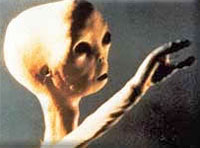 totally
obvious to scientists and society in general, the ETs are following
a strategy or programme that avoids inflicting catastrophic shock to
society as a whole, which any overt contact could cause, while
preparing us for eventual open contact. This could say something
about their level of ethics. totally
obvious to scientists and society in general, the ETs are following
a strategy or programme that avoids inflicting catastrophic shock to
society as a whole, which any overt contact could cause, while
preparing us for eventual open contact. This could say something
about their level of ethics.
Proposing a certain level of ET ethics is not new; it was suggested
in 1981 that advanced ETs may abide by a Codex Galactica that would
require them to treat emerging civilizations delicately
[1,45]. Such
a standard of behavior is consistent with reality of the UFO
phenomenon and the fact that not in the past 56 years, nor in past
millennia, have we been colonized, conquered or exterminated, nor
has society been traumatized by any ETs or by their sometimes
postulated robotic probes [1,45].
It is also consistent with the
failure of investigative panels to find that UFOs constitute any
direct threat to national security. On the other hand, it appears
all too evident that ETs have not intervened in world affairs in any
benevolent manner that would have forestalled human warfare, famine
and disease. In fact, ample cases exist wherein the witnesses, when
too close, were injured or harmed. Other cases exist, however, in
which a witness was healed of some injury or medical condition
[46].
All this suggests that ET interactions with humans are based on a
neutrally benevolent ethical level overall.
7. Conclusions
Despite the UFO phenomenon having continued now for over two
generations, the huge technological head start of the presumed ETs
would still come as a great shock to many scientists as well as
citizenry, as
the Brookings Report indicated
[47]. It could be so
great as to seriously challenge our consensual reality, a not
insignificant danger. The implication that we would be powerless
relative to their presumed capabilities and evolutionary advantage
may be most unwelcome, with it being no surprise that science would
have difficulty coming to terms with the situation
[48].
Nevertheless, the reality of the
phenomenon and of our having long since been discovered by advanced ETs now may be more probable than that Fermi’s paradox is to be
resolved through either the non-existence of advanced ETs or their
inability to explore or colonize the galaxy. Hence open scientific
research on the subject is needed with special attention paid to
high quality UFO reports exhibiting apparent indications that ET
intelligence and strategy are involved.
8.
Acknowledgments
We thank P. Sturrock of Stanford University and T. Roe of the
National Aviation Reporting Center on Anomalous Phenomena (NARCAP)
for suggested improvements.
References
-
S. Webb, “If the Universe is
Teeming with Aliens Where is Everybody? Fifty Solutions to
the Fermi Paradox and the Problem of Extraterrestrial Life”,
Copernicus Books, New York, 2002.
-
E. Dudas, “Theory and
phenomenology of type I strings and M- theory”, Class.
Quant. Grav., 17, R41, 2000, (hep-ph/0006190).
-
K.D. Olum, “Conflict between
anthropic reasoning and observation”, ANALYSIS, 64, p.1,
2004, (gr-qc/ 0303070).
-
S. Udry, M. Mayor, and N.C.
Santos, “Statistical properties of exoplanets. I. The period
distribution: Constraints for the migration scenario”,
Astron. Astrophys. , 407, p.369, 2003.
-
B.C. Coughlin, “Searching for an
alien haven in the heavens”, Proc. Natl. Acad. Sci. U.S.A.,
98, p.796, 2001.
-
D.P.Glavin, O. Botta, G. Cooper,
and J.L. Bada, “Identification of amino acid signatures in
carbonaceous chondrites”, Proc. Natl. Acad. Sci. U.S.A. ,
98, p.2138, 2001.
-
M.K. Wallis and N.C.
Wickramasinghe, “Interstellar transfer of planetary
microbiota”, Mon. Not. R. Astron. Soc., 348, p.52, 2004.
-
W.M. Napier, “A mechanism for
interstellar panspermia”, Mon. Not. R. Astron. Soc., 348,
p.46, 2004.
-
M.S. Morris, and K.S. Thorne,
“Wormholes in spacetime and their use for interstellar
travel: A tool for teaching general relativity”, Am. J.
Phys., 56, p.395, 1988.
-
M. Visser, “Lorentzian
Wormholes: From Einstein to Hawking”, AIP Press, Woodbury,
New York, 1996.
-
M. Alcubierre, “The warp drive:
Hyper-fast travel within general relativity”, Class. Quant.
Grav., 11, p.L73, 1994.
-
H.E. Puthoff, “SETI, the
velocity-of-light limitation, and the Alcubierre warp drive:
An integrating overview”, Phys. Essays, 9, p.156, 1996.
-
S.V. Krasnikov, “Hyperfast
Interstellar Travel in General Relativity”, Phys. Rev. D,
57, p.4760, 1998.
-
R.H. Dicke, “Gravitation without
a Principle of Equivalence”, Rev. Mod. Phys., 29, p.363,
1957.
-
H.E. Puthoff,
“Polarizable-vacuum (PV) approach to general relativity”,
Found. Phys., 32, p.927, 2002.
-
M.J. Pfenning, and L.H. Ford,
“The unphysical nature of warp drive”, Class. Quant. Grav.,
14, p.1743, 1997.
-
M. Visser, S. Kar, and N.
Dadhich, “Traversable wormholes with arbitrarily small
energy condition violations”, Phys. Rev. Lett., 90,
p.201102-1, 2003.
-
H.E. Puthoff, S.R. Little, and
M. Ibison, “Engineering the zero-point field and polarizable
vacuum for interstellar flight”, JBIS, 55, p.137, 2002.
-
C.H. Lineweaver, Y. Fenner, and
B.K. Gibson, “The galactic habitable zone and the age
distribution of complex life in the Milky Way”, Science,
303, p.59. 2004.
-
D.M. Jacobs, “The UFO
Controversy in America”, Indiana University Press,
Bloomington, Indiana, 1975.
-
Project Blue Book Special Report
No. 14, 1955.
-
E.U. Condon, and D.S. Gillmor,
“Final Report of the Scientific Study of Unidentified Flying
Objects”, Bantam Books, New York, 1969.
-
R.M. Dolan, “UFOs and the
National Security State”, Hampton Roads Publishing Co.,
Charlottesville, Virginia, 2002.
-
R.H. Hall, “The UFO Evidence”,
vol. II, Scarecrow Press, Lanham, Maryland, 2001.
-
P.A.Sturrock, “The UFO Enigma: A
New Review of the Physical Evidence”, Warner Books, New
York, 1999.
-
P.A. Sturrock, “An analysis of
the Condon Report on the Colorado UFO project”, J. Sci.
Exploration, 1, p.75, 1987.
-
J.E. McDonald, “Science in
Default”, in “UFO’s-A Scientific Debate”, Eds. C. Sagan and
T. Page, Cornell University Press, Ithaca, NY, 1972, p.52,
1972.
-
S.J. Dick, “The Biological
Universe: The Twentieth-Century Extraterrestrial Life Debate
and the Limits of Science”, Cambridge University Press,
England, 1996.
-
D.R. Saunders and R.R. Harkins,
“UFOs? Yes! Where the Condon Committee Went Wrong: The
inside story by an ex-member of the official study group”,
World Publishing, New York, 1969.
-
J.E. McDonald, Review of “The
Condon Report, Scientific Study of Unidentified Flying
Objects”, Icarus, 11, p.443, 1969.
-
B. Maccabee, “Photometric
properties of an unidentified bright object seen off the
coast of New Zealand”, Appl. Opt., 19, p.1745, 1980.
-
B. Maccabee, “Analysis and
discussion of the images of a cluster of periodically
flashing lights filmed off the coast of New Zealand”, J. Sci.
Exploration, 1, p.149, 1987.
-
B. Maccabee, “UFO-FBI
Connection: The Secret History of the Government’s
Cover-Up”, Llewellyn Publications, St. Paul, Minnesota,
2000.
-
See, e.g.,
http://www.nicap.org/bigsurdir.htm
-
R. Hillenkoetter, New York
Times, February 28, 1960.
-
P.A. Sturrock, et al. “Physical
evidence related to UFO reports: The proceedings of a
workshop held at the Pocantico Conference Center, Tarrytown,
New York, September 29-October 4, 1997”, J. Sci.
Exploration, 12, p.179, 1998.
-
J. Tarter, Book review
(astronomy): “Ongoing debate over cosmic neighbors”,
Science, 299, p.46, 2003.
-
B. Gato-Rivera, “Brane worlds,
the subanthropic principle, and the undetectability
conjecture”, (physics/ 0308078), 2003.
-
T.B.H. Kuiper, and M. Morris,
“Searching for extraterrestrial civilizations”, Science,
196, p.616, 1977.
-
J.A. Ball, “The zoo hypothesis”,
Icarus, 19, p.347, 1973.
-
G.D. Brin, “The ‘Great silence’:
The controversy concerning extraterrestrial intelligent
life”, Q. J. R. Astron. Soc., 24, p.283, 1983.
-
E.R. Harrison, “Cosmology”,
Cambridge University Press, Cambridge, 1981.
-
J.W. Deardorff, “Possible
extraterrestrial strategy for Earth”, Q. J. R. Astron. Soc.,
27, p.94, 1986.
-
R. Haines, “CE-5 Close
Encounters of the Fifth Kind”, Sourcebooks, Naperville,
Illinois, 1998.
-
W.I. Newman and C. Sagan,
“Galactic civilizations: Population dynamics and
interstellar diffusion”, Icarus , 46, p.293, 1981.
-
P.E. Dennett, and C. Dennett,
“UFO Healings”, Granite Publishing Group, Columbus, North
Carolina, 1996.
-
U.S. House of Representatives
Report No. 242, “Proposed Studies on the Implications of
Peaceful Space Activities for Human Affairs”, 1961.
-
P.A. Sturrock, “Extraterrestrial
intelligent life”, Q. J. R. Astron. Soc., 19, p.521, 1989.
|



 Alamos
over lunch one day in 1950. Whether one assumes the existence of
only one other civilization or of many alien civilizations in our
Milky Way galaxy, and whether one assumes colonization involving
interstellar travel at near-light speed or far below, diffusion
modeling predicts colonization or at least visitation of all
habitable planets in the galaxy on timescales of tens of millions of
years, far less than the approximate 13 x 109 year age of the galaxy
itself.
Alamos
over lunch one day in 1950. Whether one assumes the existence of
only one other civilization or of many alien civilizations in our
Milky Way galaxy, and whether one assumes colonization involving
interstellar travel at near-light speed or far below, diffusion
modeling predicts colonization or at least visitation of all
habitable planets in the galaxy on timescales of tens of millions of
years, far less than the approximate 13 x 109 year age of the galaxy
itself.  findings
and studies make plausible the hypothesis that there is intelligent
life elsewhere in the universe. This is, of course, the fundamental
assumption made by the proponents of SETI, the Search for
Extraterrestrial Intelligence using microwave or optical means of
detection.
findings
and studies make plausible the hypothesis that there is intelligent
life elsewhere in the universe. This is, of course, the fundamental
assumption made by the proponents of SETI, the Search for
Extraterrestrial Intelligence using microwave or optical means of
detection. Book’s
sightings from 1953-1965 were left unexplained, if their
‘insufficient data’ category is included
[22]. The Battelle Memorial
Institute (BMI; Columbus, Ohio) discovered, in their study of 3,201
reports from 1947 through 1952, that the percentage of unknowns
(unexplainable sightings) increased with increasing quality of the
sighting information and reliability of the observers
[21]. A
surprisingly high percentage, 30%, of the civilian sightings, and an
even more surprising 38%, of the military sightings rated as
excellent in quality were listed as unknown.
Book’s
sightings from 1953-1965 were left unexplained, if their
‘insufficient data’ category is included
[22]. The Battelle Memorial
Institute (BMI; Columbus, Ohio) discovered, in their study of 3,201
reports from 1947 through 1952, that the percentage of unknowns
(unexplainable sightings) increased with increasing quality of the
sighting information and reliability of the observers
[21]. A
surprisingly high percentage, 30%, of the civilian sightings, and an
even more surprising 38%, of the military sightings rated as
excellent in quality were listed as unknown.  enthusiastic
way since it offered an end to a troublesome situation. An
endorsement of the Report by the National Academy of Sciences took
place following an unusually rapid review and the Air Force quickly
used the Report as a justification to terminate any further public
involvement with the topic.
enthusiastic
way since it offered an end to a troublesome situation. An
endorsement of the Report by the National Academy of Sciences took
place following an unusually rapid review and the Air Force quickly
used the Report as a justification to terminate any further public
involvement with the topic. not
feel reluctant to study these inasmuch as the Report’s executive
summary stated that ‘any scientist with adequate training and
credentials who does come up with a clearly defined, specific
proposal for study [of UFO reports] should be supported.’
not
feel reluctant to study these inasmuch as the Report’s executive
summary stated that ‘any scientist with adequate training and
credentials who does come up with a clearly defined, specific
proposal for study [of UFO reports] should be supported.’ Much
of this information has been disclosed in the years since 1968.
The information release has come about on five fronts.
Much
of this information has been disclosed in the years since 1968.
The information release has come about on five fronts. connection
with SETI in the past three decades. SETI has proceeded on the
assumption that Fermi's paradox is to be solved through continued
and enhanced searching of the sky for electromagnetic signals
indicative of ET communications [37]. Several possible reasons for
lack of success to date have been proposed
[1,37-38].
connection
with SETI in the past three decades. SETI has proceeded on the
assumption that Fermi's paradox is to be solved through continued
and enhanced searching of the sky for electromagnetic signals
indicative of ET communications [37]. Several possible reasons for
lack of success to date have been proposed
[1,37-38]. totally
obvious to scientists and society in general, the ETs are following
a strategy or programme that avoids inflicting catastrophic shock to
society as a whole, which any overt contact could cause, while
preparing us for eventual open contact. This could say something
about their level of ethics.
totally
obvious to scientists and society in general, the ETs are following
a strategy or programme that avoids inflicting catastrophic shock to
society as a whole, which any overt contact could cause, while
preparing us for eventual open contact. This could say something
about their level of ethics.